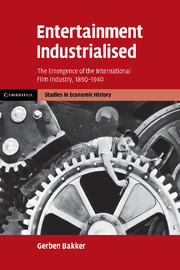Book contents
- Frontmatter
- Contents
- List of figures
- List of tables
- Acknowledgements
- Prologue
- 1 Introduction
- Part I The rise of entertainment
- 2 The emergence of national entertainment markets
- 3 The increase in demand for entertainment
- 4 The structure of household entertainment expenditure
- Part II The rise of the international film industry
- Part III Entertainment Industrialised
- Bibliography
- Index
2 - The emergence of national entertainment markets
Published online by Cambridge University Press: 08 July 2009
- Frontmatter
- Contents
- List of figures
- List of tables
- Acknowledgements
- Prologue
- 1 Introduction
- Part I The rise of entertainment
- 2 The emergence of national entertainment markets
- 3 The increase in demand for entertainment
- 4 The structure of household entertainment expenditure
- Part II The rise of the international film industry
- Part III Entertainment Industrialised
- Bibliography
- Index
Summary
Throughout the Western world, theatrical entertainment was a highly regulated and restricted activity. Before the advent of the daily, large-circulation newspapers it was the only medium that could reach large groups of people instantly and at the same time. It thus had the potential to stir popular sentiments and even to result in unrest and uprisings. The Belgian revolution of 1830, for example, was set off by an opera, Auber's La Muette de Portici. Since stage productions could be used for political purposes, and since few other mass media were available to reach the popular classes, most governments deemed control of the stage essential to the maintenance of order and stability.
The British colonies of North America all had their restrictions and regulations on theatre, as did the early states of the union. Some states, such as Massachusetts and Rhode Island, had laws that completely forbade theatres and stage performances. Others required licences for theatre buildings that were seldom awarded and only under strict conditions. In addition, many states required licences for plays and individual performances. As a consequence, theatre buildings hardly existed. The first wooden building was constructed in Williamsburg, Virginia, in 1716, but this fixed theatre seems to be a much-noticed exception rather than a rule. Travelling musicians and performers performed in barns, taverns or the open air. From the 1740s onwards, some theatre companies from Britain visited the US, and also more temporary wooden theatre buildings were erected.
- Type
- Chapter
- Information
- Entertainment IndustrialisedThe Emergence of the International Film Industry, 1890–1940, pp. 17 - 71Publisher: Cambridge University PressPrint publication year: 2008



